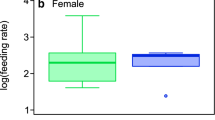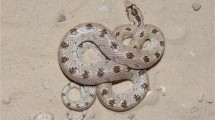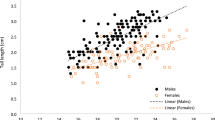Summary
Energy reserve utilization and energy budgets were compared in tailed and tailless adult female Coleonyx brevis. Carcass, fat body and caudal energy reserves were used for vitellogenesis; mass and energy content (cal/mg and/or cal/reserve) of each were significantly lower at oviposition than at the initiation of vitellogenesis. Total energy reserves accounted for 53% of the reproductive energy investment in tailed females compared to 29% in tailless females. Tailed females had over twice as many reserve calories for egg production than tailless females. Caudal energy reserves represented 60% of the total reserves of tailed females and were one-third greater than the total energy reserves of tailless females. To produce a clutch of eggs both tailed and tailless females supplemented energy reserves with net metabolizable energy that was available after metabolic costs were paid. Tailless females had a significantly greater rate of food ingestion and more net metabolizable energy available for reproduction than tailed females, yet allocated significantly fewer calories/day to reproduction than tailed females, primarily because of the loss of caudal reserves. Reproductive efforts of tailed and tailless females were equivalent. However, the loss of caudal reserves resulted in the production of eggs that were significantly lower in mass and energy content (cal/mg and cal/egg) than when caudal reserves were used. Results empirically support the hypothesis that reproduction has energetic priority over tail regeneration in short-lived, iteroparous species with a low probability of future reproductive success.
Similar content being viewed by others
References
Andrews RM (1979) Reproductive effort of female Anolis limifrons (Sauria: Iguanidae). Copeia 1979:620–626
Ballinger RE (1973) Experimental evidence of the tail as a balancing organ in the lizard, Anolis carolinensis. Herpetologica 29:65–66
Ballinger RE (1977) Reporductive strategies: Food availability as a source of proximal variation in a lizard. Ecology 58:628–635
Bartholomew GA (1972) Energy metabolism. In: MS Gordon (ed), Animal physiology: Principles and adaptations. The Macmillan Company, New York p 44–72
Bennett AF, Dawson WR (1976) Metabolism. In: C Gans, WR Dawson (eds) Biology of the Reptilia Vol 5, (Physiology A). Academic Press, New York p 127–223
Brody S (1945) Bioenergetics and growth. Reinhold, New York
Brown AV, Fitzpatrick LC (1978) Life history and population energetics of the Dobson Fly, Corydalus cornutum Ecology 59:1091–1108
Brown CK, Ruby DE (1977) Sex-associated variation in the frequencies of tail autotomy in Sceloporus jarrovi (Sauria: Iguanidae) at different elevations. Herpetologica 33:380–387
Bustard HR (1967) Gekkonid lizards adapt fat storage to desert environments. Science 158:1197–1198
Clark DR (1971) The strategy of tail autotomy in the ground skink, Lygosoma laterale. J Exp Zool 176:295–302
Cody ML (1966) A general theory of clutch size. Evolution 20:174–184
Congdon JD (1977) Energetics of the montane lizard Sceloporus jarrovi: A measure of reproductive effort. Ph D diss Arizona State University, Tempe pp 110
Congdon JD, Vitt LJ, Hadley NF (1978) Parental investment: Comparative reproductive energetics in bisexual and unisexual lizards, genus Cnemidophorus. Am Nat 112:509–521
Congdon, JD, Vitt LJ, King WW (1974) Geckos: Adaptive significance and energetics of tail autotomy. Science 184:1379–1380
Crump ML, Kaplan RH (1979) Clutch energy partitioning of tropical tree frogs (Hylidae) Copeia 1979:626–635
Derickson WK (1976) Lipid storage and utilization in reptiles. Am Zool 16:711–723
Dial BE (1975) Aspects of the ecology and systematics of the lizards Coleonyx brevis and Coleonyx reticulatus (Lacertilia: Gekkonidae). MS thesis Texas A & M University, College Station pp 211
Dial BE (1978)a Aspects of the behavioral ecology of two Chihuahuan Desert geckos (Reptilia, Lacertilia, Gekkonidae). J Herpetol 12:209–216
Dial BE (1978)b The thermal ecology of two sympatric, nocturnal Coleonyx (Lacertilia: Gekkonidae) Herpetologica 34:194–201
Edmunds M (1974) Defense in animals: A survey of anti-predator defenses. Longmas, New York
Etheridge R (1967) Lizard caudal vertebrae. Copeia 1967:699–721
Ferguson GW, Bohlen CH (1978) Demographic analysis: A tool for the study of natural selection of behavioural traits. In: Greenberg N, Maclean PD (eds), Behavior and neurology of lizards: An interdisciplinary colloquium. DHEW Publ No (ADM) 77–491, NIMH, Rockville, Maryland
Ferguson GW, Brockman, T (1980) Geographic differences of growth rate of Sceloporus lizards (Sauria: Iguanidae) Copeia 1980:259–264
Fisher, RA (1930) The genetical theory of natural selection. Clarendon Press, Oxford, (reprinted, Dover, New York, 1958)
Fitzpatrick LC (1973) Energy allocation in the Allegheny Mountain salamander, Desmognathus ochrophaeus. Ecol Monogr 43:43–58
Greene HW (1969) Fat storage in females of an introduced lizard, Hemidactylus turcicus, from Texas Texas J Sci 21:233–235
Hahn WE, Tinkle DW (1965) Fat body cycling and experimental evidence for its adaptive significance to ovarian follicle development in the lizard Uta stansburiana. J Exp Zool 158:79–86
Hirshfield MF (1980) An experimental analysis of reproductive effort and cost in the Japanese medaka, Oryzias latipes. Ecology 61:282–292
Hirshfield MF, Tinkle DW (1975) Natural selecion and the evolution of reproductive effort. Proc Nat Acad Sci USA 72:2227–2231
Hughes A, New D (1959) Tail regeneration in the gekkonid lizard Sphaerodactylus. J Embryol Exp Morphol 7:281–302
Johnson JA, Brodie ED (1974) Defensive behaviour of the western banded gecko, Coleonyx variegatus. Anim Behav 22:684–687
Johnson RN, Lillywhite HB (1979) Digestive efficiency of the omnivorous lizard Klauberina riversiana. Copeia 1979:431–437
Kaplan RH (1980a) Ontogenetic energetics in Ambystoma, Physiol Zool 53:43–56
Kaplan RH (1980b) The implications of ovum size variability for offspring fitness and clutch size within several populations of salamanders (Ambystoma) Evolution 34:51–64
Licht P, Gorman GC (1970) Reproductive and fat cycles in Caribbean Anolis lizards. Univ Calif Publ Zool 95:1–52
Maiorana VC (1977) Tail autotomy, functional conflicts and their resolution by a salamander. Nature 265:533–535
Moffat LA, Bellairs ADA (1964) The regenerative capacity of the tail in embryonic and post-natal lizards (Lacerta vivipara) J Embryol Exp Morphol 12:769–786
Murphy GI (1968) Pattern in life history and the environment. Am Nat 102:391–403
Paine RT (1971) The measurement and application of the calorie to ecological problems. Annu Rev Ecol Syst 2:145–164
Phillipson J (1964) A miniature bomb calorimeter for small biological samples Oikos 15:130–139
Pianka ER (1969) Sympatry of desert lizards (Ctenotus) in western Australia. Ecology 50:1012–1030
Pianka ER (1976) Natural selection of optimal reproductive tactics. Am Zool 16:775–784
Pond CM (1978) Morphological aspects and the ecological and mechanical consequences of fat deposition in wild vertebrates. Annu Rev Ecol Syst 9:519–570
Price PW (1974) Strategies for egg production. Evolution 28:76–84
Randolph PA, Randolph JC, Barlow CA (1975) Age-specific energetics of the pea aphid, Acyrthosiphon piscum. Ecology 56:359–369
Randolph PA, Randolph JC, Mattingly K, Foster MM (1977) Energy costs of reproduction in the cotton rat., Sigmodon hispidus Ecology 58:31–45
Schaffer WM (1974) Selection for optimal life histories: The effects of age structure. Ecology 55:291–303
Schoener TW, Schoener A (1980) Ecological and demographic correlates of injury rates in some Bahamian Anolis lizards. Copeia 1980:839–850
Shaffer HB (1978) Relative predation pressure on salamanders (Caudata: Plethodontidae) along an altitudinal transect in Guatemala. Copeia 1978:268–272
Smith CC, Fretwell (1974) The optimal balance between size and number of offspring. Am Nat 108:499–506
Smith HM (1946) Handbook of lizards. Comstock Publ Co, Ithaca, New York
Smyth M (1974) Changes in the fat stores of the skinks Morethia boulengeri and Hemiergis peronii (Lacertilia). Aust J Zool 22:135–145
Sokal RF, Rohlf FJ (1969) Biometry. WH Freeman and Co, San Francisco, CA pp 776
Stearns SC (1976) Life history tactics: A review of the ideas. Q Rev Biol 51:3–47
Stearns SC (1977) The evolution of life history traits: A critique of the theory and a review of the data. Annu Rev Ecol Syst 8:145–171
Tinkle DW (1969) The concept of reproductive effort and its relation to the evolution of life histories of lizards. Am Nat 103:501–516
Tinkle DW, Hadley NF (1975) Lizard reproductive effort: Caloric estimates and comments on its evolution. Ecology 56:427–434
Urban EK (1965) Quantitative study of locomotion in teiid lizards. Anim Behav 13:513–529
Vitt LJ (1974) Winter aggregations, size classes, and relative tail breaks in the tree lizard, Urosaurus ornatus (Sauria: Iguanidae). Herpetologica 30:182–183
Vitt LJ, Congdon JD, Dickson NA (1977) Adaptive strategies and energetics of tail autotomy in lizards. Ecology 58:326–337
Vitt LJ, Congdon JD, Hulse AC, Platz JE (1974) Territorial aggressive encounters and tail breaks in the lizard Sceloporus magister. Copeia 1974:990–993
Wake DB, Dresner IG (1967) Functional morphology and evolution of tail autotomy in salamanders. J Morphol 22:265–306
Werner YL (1968) Regeneration frequencies in geckos of two ecological types (Reptilia: Gekkonidae). Vie Milieu Ser C 19:199–222
Wilbur HM (1977) Propagule size, number, and dispersion pattern in Ambystoma and Asclepias. Am Nat 111:43–68
Williams GC (1966 a) Adaptation and natural selection: A critique of some current evolutionary thought. Princeton University Press. Princeton, New Jersey pp 307
Williams GC (1966 b) Natural selection, the costs of reproduction, and a refinement of Lack's principle. Am Nat 100:687–692
Author information
Authors and Affiliations
Rights and permissions
About this article
Cite this article
Dial, B.E., Fitzpatrick, L.C. The energetic costs of tail autotomy to reproduction in the lizard Coleonyx brevis (Sauria: Gekkonidae). Oecologia 51, 310–317 (1981). https://doi.org/10.1007/BF00540899
Received:
Issue Date:
DOI: https://doi.org/10.1007/BF00540899




